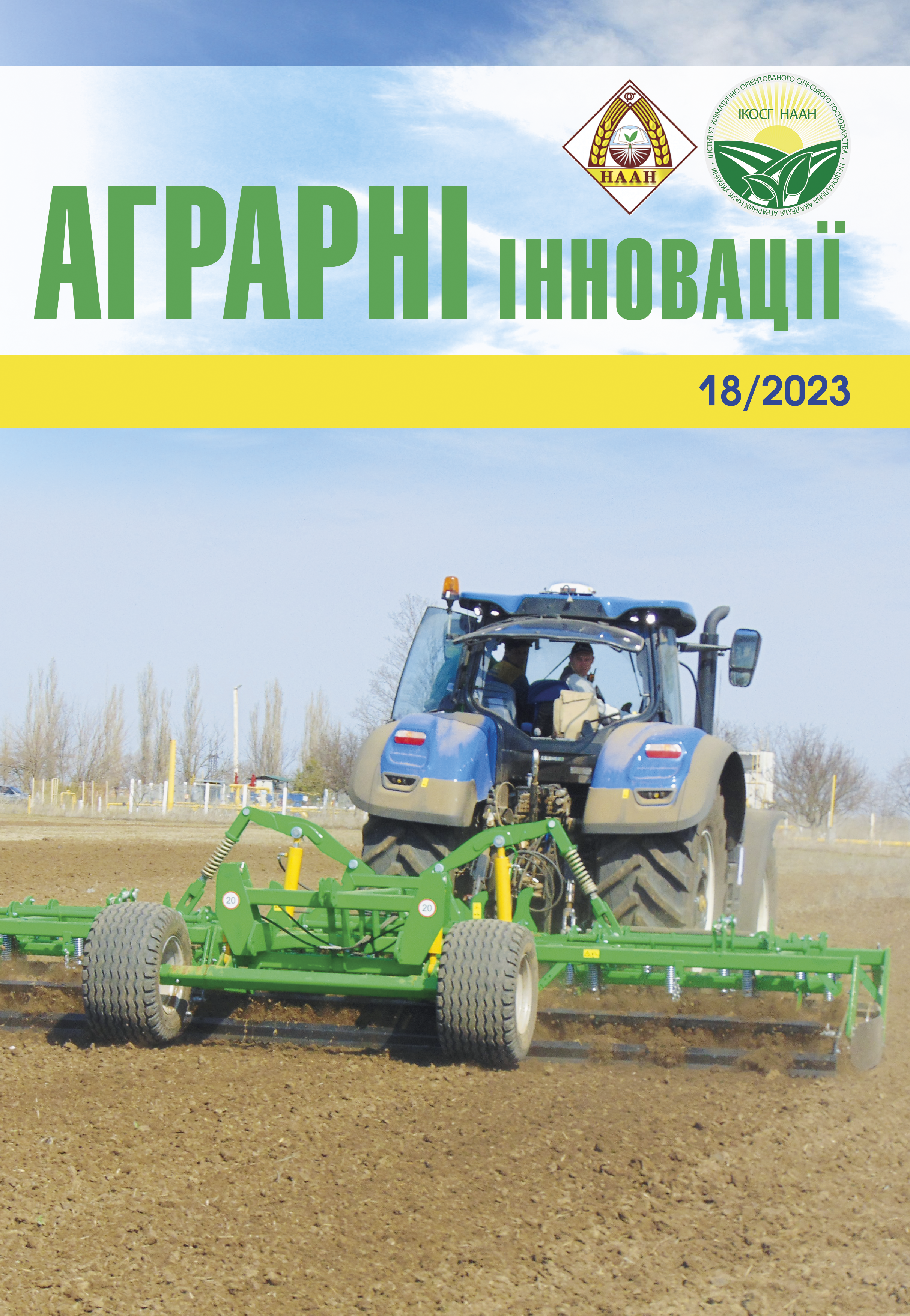YIELD OF WINTER WHEAT IN STEPPE CROP ROTATIONS DEPENDING ON FERTILIZER SYSTEMS AND BIOLOGICAL PRODUCT
Abstract
Winter wheat is one of the main food crops in Ukraine and the world. Our country is a major exporter of wheat grain, and therefore the issue of increasing gross harvest and improving the quality of the products is becoming more important. Today, due to certain factors, such as climate change and the use of modern technology, sciencebased crop rotation, and fertilization systems are becoming increasingly important. The application of any agricultural measure determines the level of winter wheat yield. To realize the potential of winter wheat in the steppe region, we researched the impact of precursors, fertilizer systems, and biological products on the formation of crop productivity. The purpose of the study to substantiate the dependence of winter wheat yield in short rotation crop rotations on fertilizer systems and biological products. Methods. Research methods are field and laboratoryfield experiments. When conducting research, generally accepted methods were used. The design of the experiment is by the method of randomized block repetitions, each crop rotation is a separate block. The experiment was laid out on plots leveled by natural fertility and topography after spring barley. Results. According to the obtained results, the highest yield of winter wheat in grain-steam-row crop rotation was obtained when using the organo-mineral fertilization system with the bio preparation Micofrend (6.18 t/ha), the increase from mineral fertilizers was 0.56 t/ha, fertilizers with residues – 0.62 t/ha, and in complex application with seed treatment with a bio preparation, respectively, 0.43 and 0.50 t/ha. A significant increase in yield was obtained due to the biological preparation, which was recorded in the version without fertilizers – 0.45 t/ha, in the version with mineral fertilizers – 0.32 t/ha, and in the version with mineral fertilizers and by-products of the predecessor – 0.33 t/ha. In the second crop rotation, when winter wheat was grown on the predecessor of soybeans, the higher yield was recorded in options with an organo-mineral fertilization system with seed treatment with a bio preparation and amounted to 5.93 t/ha. The use of biological preparation provides a significant increase in yield both in the background without fertilizers and in combination with various fertilization systems. We also received a significant increase in the yield of winter wheat grain in the third crop rotation, with 60% soy saturation, which ranged from 1.13 t/ha (25.5%) with a mineral fertilizer system in combination with a biological preparation to 1.62 t/ha and options with an organo-mineral fertilization system. Due to the use of biological preparation, productivity increased by 14.1% against the background without fertilizers and 8.9% against the background with the mineral fertilization system. Findings. The crop rotation factor ensured the highest yield of winter wheat in the grain-fallow-row crop rotation compared to the crop rotations with a greater saturation of soybeans and without a field of black steam. During the research period, the highest yield of winter wheat was obtained in the grain-steam-row crop rotation under the conditions of 2022, both in the version without fertilizers and when using the organo-mineral fertilization system in combination with biological preparation. The use of the biological preparation Micofrend in versions without fertilizers and against the background of different fertilization systems provided an increase in productivity by 0.22–0.55 t/ha.
References
2. Семеняка І., Мащенко Ю., Гайденко О. Сівозміна та удобрення – елементи доброго врожаю озимини – Агробізнес сьогодні. Агробізнес сьогодні. URL: http://agro-business.com.ua/ahrarni-kultury/item/9271- sivozmina-ta-udobrennia-elementy-dobroho-vrozhaiuozymyny. html (дата звернення: 25.04.2023).
3. Єщенко В. Роль сівозміни у сучасному землеробстві. Землеробство: Міжвід. темат. наук. зб. 2015. № 1. С. 23–27.
4. Камінський В. Сівозміна як основа сталого землекористування та продовольчої безпеки України. Збірник наукових праць НННЦ «Інститут землеробства НААН». 2015. № 2. С. 3–13.
5. Продуктивність культур у короткоротаційних сівозмінах залежно від обробітку ґрунту й удобрення в умовах Лісостепу України / С.В. Поспєлов та ін. Вісник Полтавської державної аграрної академії. 2020. № 4. С. 69–79. URL: https://doi.org/10.31210/ visnyk2020.04.08 (дата звернення: 25.04.2023).
6. Філоненко С.В., Тищенко М.В. Урожайність пшениці озимої в короткоротаційній просапній сівозміні залежно від удобрення й основного обробітку ґрунту. Вісник Полтавської державної аграрної академії. 2020. № 3. С. 61–69. URL: https://doi.org/10.31210/visnyk2020.03.07 (дата звернення: 25.04.2023).
7. Вплив попередників на урожайність та якість зерна нових сортів пшениці озимої твердої / С.М. Шакалій та ін. Вісник Полтавської державної аграрної акаде- мії. 2021. № 1. С. 65–71. URL: https://doi.org/10.31210/ visnyk2021.01.07 (дата звернення: 25.04.2023).
8. Гангур В.В., Котляр Я.О. Вплив попередників на водоспоживання та продуктивність пшениці озимої в зоні лівобережного Лісостепу України. Вісник Полтавської державної аграрної академії. 2021. № 1. С. 122–127. URL: https://doi.org/10.31210/ visnyk2021.01.14 (дата звернення: 25.04.2023).
9. Барштейн Л.А., Шкаредний І.С., Одрехівський О.Г. Залежність родючості ґрунту та продуктивності цукрових буряків від сівозмін та добрив. Землеробство. 1998. № 72. С. 85–90.
10. Базалій В., Домарацький Є. Вплив біопрепаратів на врожайність і адаптивні властивості сортів пшениці м’якої озимої. Таврійський науковий вісник. 2012. № 81. С. 9–14.
11. Носко Б. Сучасний стан та перспективні напрямки досліджень в агрохімії. Вісник аграрної науки. 2002. № 9. С. 9–12.
12. Ситник В. Екологічні аспекти агропромислового комплексу. Вісник аграрної науки. 2002. № 9. С. 55–57.
13. Гамаюнова В. В., Панфілова А. В. Окупність сумісного використання добрив та біопрепаратів на пшениці озимої в Південному Степу України. Вісник Полтавської державної аграрної академії. 2019. № 1. С. 41–48. URL: https://doi.org/10.31210/ visnyk2019.01.05 (дата звернення: 25.04.2023).






